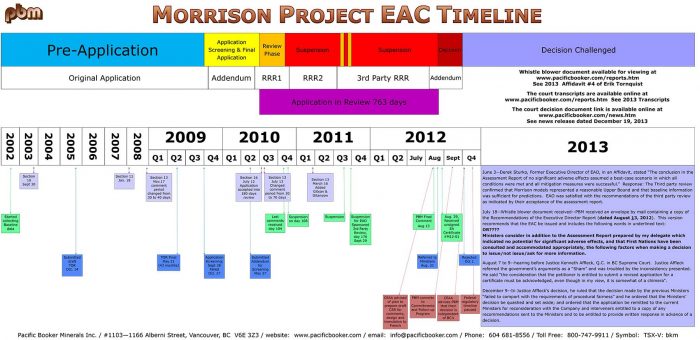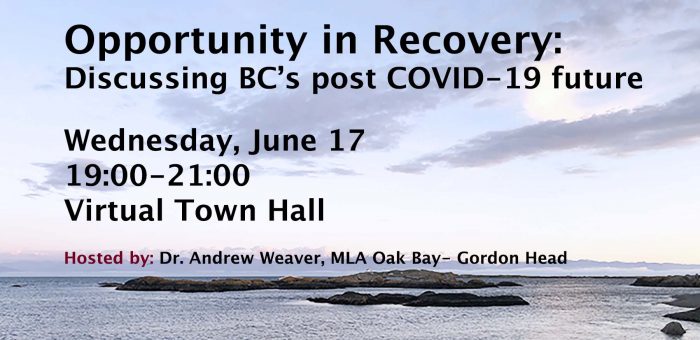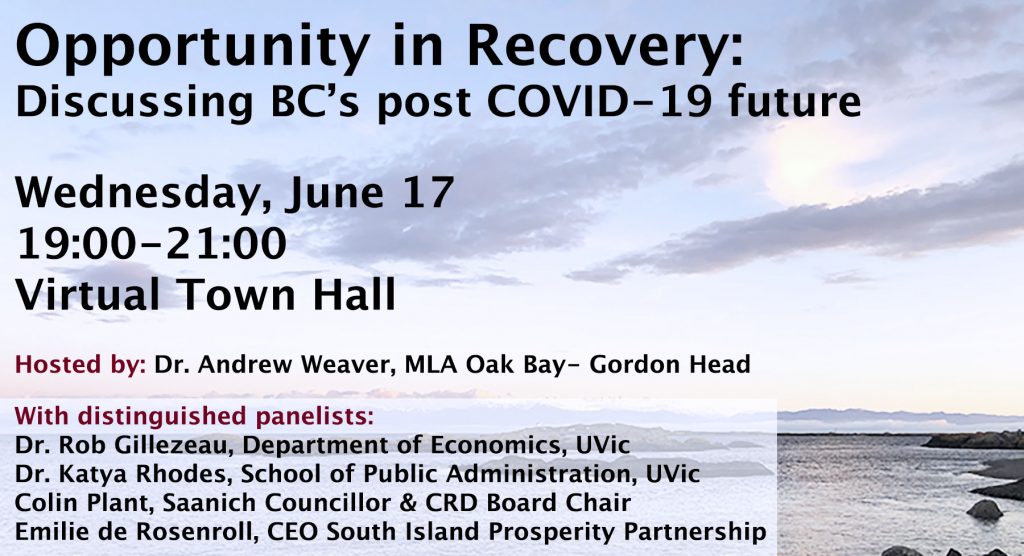Energy and Mines
Ongoing regulatory inconsistencies facing Pacific Booker’s Morrison mine project
Yesterday I published a blog post detailing the apparent regulatory inconsistencies facing the advancement of Pacific Booker’s Morrison Mine project. Today during question period I rose to explore this issue further with the Minister of Environment. Today’s question built upon an initial question I asked the Minister of Energy Mines and Petroleum Resources on March 5, 2020.
Below I reproduce the text and video of our exchange.
Video of Exchange
Question
A. Weaver: On March 5, I asked the Minister of Energy, Mines and Petroleum Resources a question concerning regulatory inconsistencies in the provincial government’s handling of Pacific Booker’s proposed Morrison mine. I’d like to explore this a little further.
In 2015, after reviewing the project for a second time, the Ministry of Environment issued a section 17 order that the project undergo further assessment. Despite numerous exchanges with the environmental assessment office and the completion of an in-depth study of Morrison Lake, Pacific Booker has been unable to clarify the precise nature of what is actually required in the section 17 order. For Pacific Booker, this order has been tantamount to a rejection of its project without the ministry formally saying no.
Government recently amended the environmental assessment process to provide certainty of process and clarity of regulatory considerations. When presented with an application for an environmental assessment certificate, the minister is given three options under the 2018 Environmental Assessment Act:
(1) grant the certificate,
(2) grant the certificate with conditions attached or
(3) reject the project.
Pacific Booker’s treatment doesn’t align with the new assessment standards. They’ve been given the opposite of regulatory certainty, and their project has been shunted off for a further assessment. My question is to the Minister of Environment. Considering the recent changes to the environmental assessment process, will he amend the 2015 order to clarify the nature of the work required by Pacific Booker Minerals?
Answer
Hon. G. Heyman: Thank you to the member for the question. I recall the question to my colleague, the Minister of Energy, Mines and Petroleum Resources, in March quite well. As the Minister of Energy and Mines said at the time, he and I can’t speak to the specifics of why the old government made the decision that it made with respect to the proposed Morrison mine.
The member is also correct. We made significant changes to the Environmental Assessment Act through revitalization, and we’re proud of that as our government. We brought new transparency to the act. We’ve included engagement of Indigenous peoples and local communities at the front end, and we have taken steps to ensure that good projects that respect the environment, that respect Indigenous peoples and that respect the public can be approved more quickly with greater certainty.
However, with regard to Pacific Booker, the member is correct. Under the old act, the decision was made to require additional information from the proponent before a final decision on the proposal was made.Under the new legislation or the transition regulation, there is no ability to take a project like Morrison that has proceeded this far down the process and transfer it to the provisions of the new act. But it’s my understanding that the company is currently working through the required regulatory process for further assessment in tandem with the environmental assessment office.
Supplementary Question
A. Weaver: Thank you, Minister, for your answer. I think the minister may have missed the point. Pacific Booker doesn’t know what the section 17 order does because what they’re supposed to do has not been conveyed to them with any certainty. So they are left with an uncertain order, of which they don’t know how to respond. So it’s not possible for them to move through the regulatory process when that process has not been defined in which they could go.
They have conducted detailed assessments of Morrison Lake and its internal wildlife, including measuring water quality and lake mixing patterns as well as investigations into fish habitat and spawning patterns. They have pledged to use cutting-edge technology to reduce groundwater seepage from the tailings storage facility. They’ve even completed a request, and they were the only one asked to do so, to comment on the implications of Mount Polley for their tailings management.
Throughout the protracted environmental assessment process, Pacific Booker has stated its preference to use local suppliers and to hire local workers. The project would generate over 1,000 jobs in the region near Smithers, and it would provide millions of dollars in tax revenue. At a time when the provincial economy is reeling due to the efforts of COVID-19, the project would give that region a much-needed economic boost.
My question, again, to the Minister of Environment is this. Given the extensive work undertaken by Pacific Booker Minerals to examine and reduce the environmental impact of the potential Morrison mine project and the potential economic benefit to the province, will this government commit to ensuring that the company receives a timely, unbiased review of the latest proposal, and in particular, is given clear instructions from your office so that it knows what boxes need to be ticked so that they can follow due process, rather than second-guessing certain people who haven’t made that very clear?
Answer
Hon. G. Heyman: Thank you again to the member for the supplemental question.
The company, of course, has to provide some very specific additional information that was required under the order. The order was specific. Some examples of the type of additional information required are sockeye salmon use of Morrison Lake, upper and lower Tahlo Creek and the Morrison River, hydrogeological and groundwater data for areas between the mine and Morrison Lake and further engagement with the Lake Babine Nation and other impacted First Nations.
I’m advised that the company made its latest submission to the environmental assessment office in December and that environmental assessment office staff met with the company this past February as additional information was required from the company. It is certainly not the intention of our government to make proponents guess at what is required. I checked with the environmental assessment office, and my understanding is that staff there are working to help answer any questions that the proponent has with respect to the information required.
I’m advised that the company plans to provide an update to the environmental assessment office regarding their next steps, and the environmental assessment office will be very happy to assist them in a timely answering of the questions required by the order. As minister, I assure that when the application is complete and ready for reconsideration, it will be considered in a timely manner.
Pacific Booker Minerals and their quest to develop Morrison Mine near Smithers
In 2002, Pacific Booker Minerals began the formal environmental assessment process required to obtain ministerial certification for Morrison Mine, their proposed copper and gold mine near Smithers, BC. A decade later, after $10 million worth of consultations, meetings, and assessments, the company decided to proceed to the next stage of the certification process in which the Environmental Assessment Office (EAO) submits a formal environmental assessment report to the relevant ministers via the executive director. At the time of submission, all indications were that the mine would receive approval. EAO assessment reports had given the project a clean assessment and the company had proposed to undertake measures unprecedented in the copper mining industry to address the project’s environmental risks. Despite the positive environmental assessment, the Executive Director of the EAO chose to recommend that the project be rejected, advice which was followed by Environment Minister Terry Lake. The decision to reject proposed project was ostensibly made due to ongoing concerns about the effects of the project on local salmon populations and water quality in Morrison lake, among other things.
Yet the decision to reject the project on environmental grounds should raise immediate questions about why this project was nixed and not others, given the BC Liberal government’s environmental record in the mining sector. As highlighted in my question posed to the Minister of Energy, Mines, and Petroleum Resources in the House back in March, this is the same government that went to Ottawa in 2014 to lobby the federal government to approve the Prosperity mine, a project that had received two negative assessments by federal review panels. Moreover, the BC Liberals presided over a compliance and enforcement regime that the auditor general described as “inadequate to protect the province from significant environmental risk” and unfunded taxpayer liabilities in the mining industry were estimated at $1.4 billion as of 2017.
The decision to reject the project had serious repercussions for Pacific Booker. Their share price plummeted from $14.95 to $4.95 in one day and many investors lost their life savings. What’s more is that the Ministry failed to inform Pacific Booker of its intention to issue an adverse recommendation and did not provide the company with an opportunity to respond to it, conduct which deviated from the standards outlined in their own user guide.
Rather than face the prospect of beginning the assessment again Pacific Booker decided to enter into litigation with the government over its decision to reject the project. Among other things, the case was fought over whether the Ministry had violated standards of procedural fairness by denying the company the chance to respond to the Executive Director’s recommendation. During the court proceedings, Justice Affleck would describe the environmental assessment process as a “sham” and accuse the province of repeatedly “moving the goalposts” during the assessment process. Perhaps unsurprisingly, the Supreme Court would rule in favour of Pacific Booker, writing that the firm “ought to have been entitled to know at least the essence of the adverse recommendations and ought to have been entitled to provide a written response”.
The ruling from the Supreme Court quashed the decision to reject the mine and ordered the project to be reconsidered by the government. Yet once again, the government elected not to approve the mine and ordered that the project undergo further assessment with the requirement that additional information be collected. Despite repeated exchanges with the environmental assessment office in which Pacific Booker attempted to determine what exactly this additional information is, the firm has been unable to obtain a clear answer from government officials, placing the project in a state of limbo. As of early 2020, the company was still in the process of working through the Supplemental Application Information Requirements with the EAO, in accordance with the order issued by the Ministers.
Based on the previous government’s environmental record in the mining sector (raised earlier), there has been speculation that the decision to reject the mine had little to do with environmental concerns and everything to do with political calculation. What could these political concerns have been? It is difficult to determine one single political factor that led to the decision around the Morrison mine but several interrelated developments which are explored in more detail below provide insight into the political circumstances surrounding the project.
Two ‘Final’ Environmental Assessment Reports
In 2013, before the court proceedings began, a whistleblower provided Pacific Booker with a copy of an assessment report on the Morrison mine dated August 21st. The report contained notable differences from its final version that was ostensibly used to inform the government’s final decision and released publicly. Subsequent emails obtained by the company through a Freedom of Information (FOI) request have revealed that the Minister had requested changes to the original document which should raise questions about the political neutrality of the decision to reject the mine. On July 16th 2014, the project assessment director Chris Hamilton wrote to Sarah Bevan: “Hmm, I recall the first PBM knew about the no was a phone call on Oct 1, a Monday. Could you be thinking about the two versions of the recommendations? One was dated Aug 21, the date of the referral and then Minister Lake had asked for changes to that doc, so the second was dated Sep 20. Could that be it?”
To date, the Ministry has denied any allegations of political interference in the environmental assessment process. In his affidavit in Pacific Booker v British Columbia, David Sturko claimed that: “The clarifications requested by Minister Lake were (a) correction of a factual error relating to the project’s anticipated contribution to Provincial Gross Domestic product, and (b) more specificity regarding the nature and basis of the additional factors I cited in my recommendations at the end of the document”.
The Relentless Pursuit of LNG
For some time, the Lake Babine Nation has been opposed to the Morrison mine. Members of the community have expressed significant concerns about the effects of the project on local salmon populations which are important to the nation for cultural, historical, and economic reasons. When the decision was made to the reject the project, a secondary justification that the director of the EAO provided in his report was the “moderate to strong” strength of the Lake Babine Nation’s claim to aboriginal title in the area. Based on the strong opposition of the nation to the project, it is possible they would have pressed an aboriginal title claim in court to delay or block the project from proceeding.
At the time the project was rejected this appeared to be the only consideration that the province had given to First Nations issues. However, subsequent developments have made political conflict involving the Lake Babine Nation increasingly salient to the delayed progress on the project. In 2016, the Lake Babine Nation cautioned the province that their cooperation on major LNG projects, including the Prince Rupert Gas Transmission line, could be contingent upon the government not overturning its decision on the Morrison mine. Referencing the pipeline, Chief Wilf Adam was quoted in Business in Vancouver as saying: “If they overturn or change their decision in favour of PBM to start this mine, then all gloves are off – and any agreement we made with the province,”.
Raising the issues that have emerged around the Lake Babine Nation is in no way meant to diminish the obligation that the government has to undertake meaningful consultation with indigenous communities before projects can proceed. Resource development needs to be based on equal partnership between all parties with interests at stake in proposed projects. Rather, highlighting the political conflict involving the Lake Babine Nation is meant to bring attention to the fact that decisions involving the Morrison mine may have been influenced by political calculation that had little to do with the proposed project itself.
Project Suspension
Just before the Ministry was ready to release the order requesting further assessment, the Morrison mine was placed under suspension after the Mount Polley Mine disaster, pending the outcome of a provincial review. At the time, the Pacific Booker was the only project that was placed under suspension while the government was investigating the Mount Polley incident. To date, no explanations have been given for why the Morrison mine was suspended and not others. The delay would last for approximately one full year before the order was released.
Pipeline Politics
At the time the project was rejected, the BC Liberals were embroiled in a dispute with Alberta over the construction of the Enbridge pipeline where the most contentious issue in negotiations was revenue sharing. The Liberals took the position that BC would need to receive a higher share of the royalties for the amount of environmental risk the province would absorb in order for the pipeline to proceed. However, comments from some observers had implied that taking this stance placed BC in a weak negotiating position due to the BC Liberal government’s poor environmental record. Further compounding the government’s problems was a looming election in which the NDP had attempted to make the Enbridge pipeline an election issue. Then BC NDP leader Adrian Dix had been heavily critical of the government’s environmental record and had accused the BC Liberals of selling out BC’s interests to the federal government and to Alberta.
Towards a Resolution?
While there is no smoking gun which serves evidence that the province had politicized the environmental assessment process, the suspicious circumstantial evidence that suggests otherwise does little to inspire confidence from British Columbians in their government and has damaged the province’s reputation as a good place to do business. Furthermore, the decision to reject the project has had significant ramifications for Pacific Booker and its investors. Small investors in the project have lost their life savings and have been forced to continue to work well into their retirement years. Based on these factors along, this government has a responsibility to ensure that this project is given a fair hearing in what is now effectively its third environmental assessment.
Opportunity in Recovery: A Discussion of BC’s post COVID-19 future
On Wednesday June 17 we held a virtual town hall to discuss BC’s post COVID-19 future and answer any related questions. It was a very successful event and I grateful to the myriad participants for their thoughtful questions and comments. We’ve had a lot of requests for a copy of the video of the event and so I’ve reproduced it below for those interested.
I wish to offer sincere thanks to the panelists Katya Rhodes, Rob Gillezeau, Colin Plant, Emilie de Rosenroll and special guests Merran Smith and the Honourable George Heyman for their insightful contributions to the town hall.
Video of Panel Presentation
Opportunity in Recovery: Discussing BC’s post COVID-19 future
Join us on June 17 for a virtual town hall hosted by Dr. Andrew Weaver, MLA for Oak Bay-Gordon Head. Dr. Weaver will be joined by distinguished panellists Dr. Rob Gillezeau, Dr. Katya Rhodes, Colin Plant, and Emilie de Rosenroll to discuss BC’s post COVID-19 future and answer any related questions you may have.
Please confirm your attendance in advance by registering using the link below.
Register in advance for this webinar:
https://us02web.zoom.us/…/register/WN_QtJOU8iGRhKQT8a7kmr75Q
After registering, you will receive a confirmation email containing information about joining the webinar.
Panellist Bios:
Dr. Katya Rhodes is an Assistant Professor in the School of Public Administration and member of the Institute for Integrated Energy Systems at the University of Victoria. She investigates the topics of low-carbon economy transitions and climate policy design using survey tools, energy-economy models, media and content analysis. Prior to joining the academia, Dr. Rhodes worked in the British Columbia (BC) Climate Action Secretariat where she led greenhouse gas (GHG) emissions modelling and economic analyses for the provincial CleanBC plan.
Dr. Rob Gillezeau joined the Department of Economics at the start of 2016. Prior to joining the department, he served as the Chief Economist in the Office of the Leader of the Official Opposition in Ottawa. Dr. Gillezeau’s research applies causal methodology from labour economics to answer questions in modern American and Canadian economic history. His work has examined questions related to the interaction of the War on Poverty and the 1960s race riots, the growth of the North American trade union movement, and the role that the Transatlantic slave trade played in the development of ethnicity on the African continent.
In 2016, Emilie de Rosenroll became the inaugural CEO of the South Island Prosperity Partnership (SIPP). She spearheaded a number of economic development initiatives, including the regional Smart Cities strategy, involving over 50 organizations and including 15 local Governments. Drawing on her extensive governance and Public-Private expertise, the first phase of the strategy focuses on transportation and mobility followed by a focus on building common data platforms along with measurement of Mobility Wellbeing.
Colin Plant is a Saanich councillor where he serves as chair of the arts, culture and heritage committee and as chair of the of the Saanich LGBTQ sub-committee. He is also drama teacher at Claremont Secondary school and is chair of the Capital Regional District Board. Originally from Salmon Arm BC, Mr. Plant graduated from Stelly’s secondary in 1990 as the class valedictorian and has lived in Saanich for 15 years.
Support for small business as the COVID-19 pandemic plays out
Over the last two weeks governments across Canada have introduced some of the most far reaching and ambitious programs in recent memory to deal with the economic fallout of COVID-19. The policymakers and civil servants behind these supports deserve to be commended for the speed at which they have acted and for their ingenuity. Despite these unprecedented government interventions into the economy it is becoming increasingly clear that the measures introduced so far are not enough. Many businesses are slipping through the cracks of the available supports and are struggling to make ends meet.
Statistics released by the BC Chamber of Commerce (BCC) and the Canadian Federation of Independent Business (CFIB) on the scale of the economic devastation brought about by COVID-19 are staggering. Two-thirds of the 1,900 businesses polled by the BCC have experienced at least a 50% decrease in revenue and over half are worried that they will face bankruptcy or be unable to resume operations when the crisis subsides. Almost 40 percent of independent businesses surveyed by the CFIB have said that the Canada Emergency Wage Subsidy will not help them and 56% said that they have no fiscal capacity to take on new debt. These statistics released by business advocacy groups are consistent with the daily emails my office has received informing us that the existing measures are not enough. Messages received by my constituency office, ongoing conversations with small businesses and reports from the media highlight gaps in the existing programs. Some of the gaps are outlined below.
Eligibility for the Canada Emergency Business Account
The Canada Emergency Business Account is open to businesses with a total payroll between $50,000.00 and $1,000,000.00 in 2019. However, there are many small businesses with 10 to 20 employees whose payroll exceeds the program’s upper limit. For instance, small health, technology and manufacturing companies whose growth the province has been trying to cultivate will be particularly hard hit by the program’s restrictions.
BC Hydro Small Business Credit
The BC Hydro Small Business Tax Credit defines “small business” as those that qualify for their Small General Service Rate. The effect of this restriction is that numerous businesses with narrow profit margins that use high amounts of electricity (i.e. local restaurants using the medium general service rate) will not be eligible for the benefit. Although BC Hydro does allow payments to be deferred, many of these bills will be due at precisely the same time when businesses will be trying to recover from the crisis.
Restrictions in the Wage Subsidy
The original structure of the Canada Emergency Wage Subsidy worked against small businesses who had experienced substantial declines in revenue but were still trying to stay open to provide services to people. Eligibility requirements originally restricted applications to businesses that have experienced at least a 30% drop in revenue when comparing one month this year to same month last year. This restriction would have meant that businesses whose revenue had decreased by 20% or even 29% would not qualify for the subsidy. The direct effects of restricting the availability of the program would have been further layoffs of workers which defeats the announced goal of the support. As it stands, within the foodservice industry 7 out of 10 businesses will continue to reduce staff hours or lay off more employees if their current situation does not improve. Recently announced changes to the bill will allow businesses to qualify for the subsidy if they can demonstrate a 15 percent drop in revenue in March. Companies will also be permitted use January or February as their base line in certain situations. These changes to the legislation show that the government is listening to business owners. However, continued monitoring is needed to determine if they adequately address the bill’s original flaws.
Profit margins and the use of a ‘one-size fits all’ approach
For many small businesses with narrow profit margins, the difference between remaining viable and facing insolvency is extremely thin, making a substantial decline in revenue potentially devastating. Given the financial position of many small businesses, the measures introduced so far may not be enough to keep them afloat. While the wage subsidy does offer some support, many businesses still have substantial fixed costs (i.e. rent, utilities). These businesses are seeing reduced revenue due to disruption in their supply chains and decreased demand in the economy. Furthermore, numerous already overextended business owners feel that they don’t have the fiscal capacity to take out additional loans. The structure of the existing programs also does little to support small businesses reliant on cyclical or seasonally dependent revenue who have recently seen their sales dry up. For businesses in this position tax deferrals or loans will become difficult to finance with their primary revenue source having evaporated.
Looking Ahead
Going forward, both the provincial and federal government will need to work together to quickly address the gaps in support measures introduced so far. Solutions which have been floated by business groups include: direct payments to business (especially those hardest-hit by the crisis), further reductions in taxes, and supports for businesses unable to pay rent. Other countries may provide models for how to respond as well. Both Norway and Demark have introduced schemes to help companies experiencing revenue losses to pay their fixed costs. Switzerland has launched a program where the small business can apply for interest free loans of up to 10 percent of their annual revenue (SFr500,000 maximum) which are fully backed by the government.
Right now, the current collapse in economic activity is happening at an unprecedented pace. Nearly one quarter of the businesses surveyed by the CFIB stated that they will be unable to make it through the next month without additional support. Within the foodservice industry almost 10 percent of restaurants have already closed and an additional 18 per cent could permanently close by the end of April if current conditions persist. Time is of the essence in getting businesses the support they need.
By expanding the available support programs for small businesses, governments will be reducing the amount of economic hardship experienced by countless numbers of people. Supporting hard-hit businesses will be an incredibly expensive in the short-term. There are major long-term benefits to ensuring that businesses are able to remain operational. Keeping more small businesses solvent throughout the pandemic will help to prevent businesses and workers from needing to re-establish their niches in the economy after the crisis abates. By acting now to support small businesses, governments will be saving central pillars within our communities. These businesses help to make our communities feel like home by providing us with a sense of place and identity. Given the importance of small businesses to our economy and communities, governments must take steps to ensure these businesses are able to emerge successfully from this crisis.







